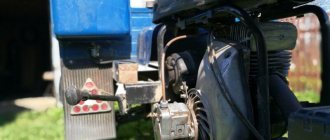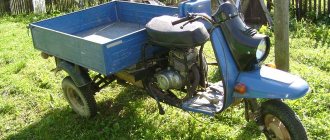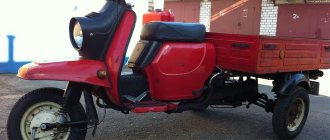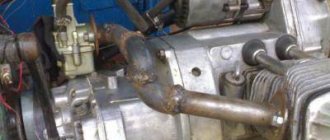How to install a Lifan engine on an Ant scooter
Recorded from the words of the author.
I got an old Ant scooter, produced in 1981, with a T-200 engine that just wouldn’t start or work properly. Having suffered with it, a decision was made to replace it with a Lifan engine. The choice fell on an 11-horsepower unit with a torque of 21 rpm, which is one and a half times more than on the native T-200
I started installing the new engine by dismantling the old engine and then washing, cleaning and reassembling it, so in the future I planned to use it as a gearbox for the new engine.
Materials
Next, we present to your attention the process of replacing the standard T-200 engine of the Ant cargo scooter with a Lifan 11 l/s made in China.
This is the condition the scooter was in before restoration and repair.
Initially, the Lifan 11 l/s engine was purchased
Using a high-precision rack, the internal combustion engine was aligned along the pulleys, holes were drilled in the plate and the engine was secured and a tension ex was installed (later it was replaced with a VAZ roller because it has sides that prevent the belt from slipping)
I bought a longer clutch cable and carried out the first “test drive” which showed that this system would exist. I began a complete disassembly of this scooter with replacement of bearings and much more for subsequent cleaning of dirt and old paint and subsequent painting and assembly.
The traction for it is enough for the eyes. The gear ratio of the internal combustion engine and gearbox is 1:1, the maximum speed is 45-50 km/h, which is quite enough on rural roads.Author: Alexey Kochnev.
We also recommend that you familiarize yourself with the experience of Evgeniy Sinitsin Installing a Lifan engine on an ant cargo scooter.
Constructive criticism is welcome, write your suggestions in the comments.
Video of the scooter working.
Source
Vehicle Upgrades
If your old bicycle, scooter or motorcycle breaks down, you should not sell the equipment for scrap. There is also no need to rush into buying a new motor. It can be replaced with a power unit from a light motor cultivator. There is only one restriction: such a car cannot be driven on public roads.
But the Ant scooter with a walk-behind tractor engine can be used in the country for trips to a field or river. 5-6 hp engine quite enough to accelerate the moped to a speed of 50-60 km/h. Before installing the engine on a bicycle, it is necessary to install reinforced wheels on this vehicle that can withstand a weight of up to 100 kg.
In order to assemble a scooter with a walk-behind tractor engine, you will need the following tools and materials:
- welding machine;
- grinder with metal discs;
- electric drill;
- wrench;
- screwdriver;
- pliers;
- level;
- hammer;
- dye.
In order to install the power unit on the Ant, you will need to create a frame for it.
This is done in the following sequence:
- Drawings are drawn up, precise calculations of the frame configuration and attachment points are made. It is recommended to check the calculations on soft aluminum strips.
- The mounting bracket is welded. It is treated with anti-corrosion agents and holes are drilled for the bolts.
- The engine is carefully placed on the bracket and secured with bolts. The installation accuracy is checked and the position is adjusted.
- The motor is connected to the vehicle's chassis using a belt or chain. Gear shift cables and control levers are secured.
- Checking the functionality of the vehicle. The created homemade product needs to be run in so that all the parts get used to each other. You need to spend 6-8 hours on this with the engine running at medium speed.
If you have experience in handling household tools and knowledge in electrical engineering, you can assemble an electric excavator with your own hands. This will require channels, hinges, cables and a working electric motor. The bucket is made of sheet steel, which can be purchased inexpensively at scrap metal collection points.
How to install a Chinese engine on an Ant scooter
During the Soviet years, this bloodsucker Ant was bought only for its body. Since nothing like this was produced in the USSR in those years. And people needed to either go to the garden or feed the farm, so they took him.
The body in the Ant is really good; you can easily load 10 bags of mixed feed, 500 kilograms of coal or half a cubic meter of firewood and it will safely trample all this junk home. On the two-seater version, the body was significantly smaller and moved far back, causing the overloaded scooter to tip over backwards on bumps. But on the two-seater version it was possible to ride together
The tailgate opens like a regular truck
In stock, the body does not have extensions. On collective farms this feature was ignored and the sides were sewn to some unrealistic size.
Tractor from a walk-behind tractor
Few people will like the process of walking around the field for many hours behind the machine. It is much easier to mow the grass, plow or hill up the soil while sitting on a comfortable chair attached to a trailed cart. There are many branded adapters, trailers and carts available at retail outlets.
The following devices and materials are needed:
- differential from a passenger car;
- wheels from a small car;
- sprockets and chains from a motorcycle;
- hexagonal solid steel profile;
- steel corners 50 mm;
- tin for making wings.
The first difficulty that arises when making a homemade tractor with your own hands is a high center of gravity. It is impossible to lower it for purely technical reasons. The only way to increase the stability of a tractor is to expand its wheelbase.
The mini-tractor is assembled in the following sequence:
- Welding the frame of the trailer part. Attaching the drawbar to the flange, making holes in it for the bolts (the connection must be made collapsible in order to be able to transport the walk-behind tractor in the trunk or trailer).
- Manufacturing of chassis. Wheels are installed on the trolley. To make all-wheel drive on both axles, sprockets are welded onto the axle shaft, and a tensioning mechanism and chains are installed.
- Assembly of body and seat. If necessary, a canopy is installed over the driver. The controls are being configured and adjusted.
- Electrification of the created machine. A tractor generator or battery is used as an energy source. For ease of driving, it is advisable to install 2 headlights - front and rear (for reversing).
Engine
The Ant engine is somewhat different from Soviet engines of that time. The most significant difference is in the starting system: here it can be done using an electric starter (this was very cool in the 50s) or using a manual kickstarter. There was no trace of an electric starter on any Soviet motorcycle of those years.
The engine is started with the starter just like a regular car: insert the key into the ignition, turn the key all the way to the right and the engine starts.
The second difference is the forced cooling of the engine
The fan drives air through the casings, cooling the cylinder and cylinder head. The cooling system works tolerably
Mechanical clutch with cable drive from a lever on the steering wheel
The gearbox is manual, the shift lever is located on the left directly under the driver’s foot. The switching algorithm is as follows: first, second, third and fourth gears are switched up. Neutral gear is at the very beginning and to engage it you need to push the gear lever down. Controversial decision, but that's how it's done here
Factory assembled
It is produced by domestic industry at agricultural engineering enterprises. It is a gasoline engine on a two-wheeled platform, capable of both rotating the wheels of the chassis and driving cutters for cultivating the soil.
“Ant” is capable of processing hard and virgin soil. In addition to the cutters, it is possible to install a plow or hiller on it. Four-stroke petrol engine with 7 horsepower. This allows you to plow the soil to a depth of 30 cm. The fuel tank holds up to 3.6 liters of gasoline, the crankcase volume is 0.6 liters.
The transmission is a belt drive and chain reducer with a cast iron pulley. Speeds can be switched when moving forward; moving backwards provides only one speed. The engine has a manual starting system. The walk-behind tractor can provide a plowed strip width of up to 80 cm.
The steering column can be adjusted both vertically and horizontally. The result is a fairly powerful and easy-to-use device. The only drawback can be considered the relatively high cost, which forces most owners of dachas and plots to prefer making its analogue with their own hands.
Electrics
The most problematic part of the Ant has always been considered its electrics, in particular the voltage regulator relay and dyno starter (generator and starter rolled into one). Due to their design features, the dyno starter and relay regulator require constant attention and qualified maintenance. If the dyno starter is not serviced on time, then it begins to undercharge the battery literally in the first season
On older models, the relay-regulator was of a mechanical type
On the latter, more advanced - electronic type
Contact ignition. The contacts are located in the cooling casing
The ignition coil and capacitor are located on the frame. In terms of repair and maintenance it is very convenient
Dynastarter
However, it is not only the engine that can make a motorcyclist clearly see all the components of his motorcycle. The most common problem is a problem with the dynastarter.
. The engineers of the Tula plant installed it in Muravya, instead of a conventional alternating current generator.
Why is it so important? If you notice a red light on the instrument panel while the moped is running, it means you are running out of charge. This happens because the generator is not producing alternating current. To begin with, in such a situation, it is necessary to check the integrity of the wires connected to the dynastarter and the relay regulator. If everything is in order, then the problem lies directly in the dynastarter. There may be three main causes of problems:
- difficulty in rotor operation (dirt getting into the collector or dust accumulation);
- freezing or wear of brushes;
- violation of the integrity of electrical equipment.
Since in most cases the operation of the dynastarter is difficult due to contamination of the collector, it is worth carrying out a simple disassembly according to the instructions described in the moped operating book. The main rules when working are neatness and cleanliness. After disassembly, be sure to thoroughly rinse all parts in gasoline and lubricate the rubbing parts, and under no circumstances throw away the parts.
How to install a Lifan engine on an Ant scooter
Recorded from the words of the author.
I got an old Ant scooter, produced in 1981, with a T-200 engine that just wouldn’t start or work properly. Having suffered with it, a decision was made to replace it with a Lifan engine. The choice fell on an 11-horsepower unit with a torque of 21 rpm, which is one and a half times more than on the native T-200
I started installing the new engine by dismantling the old engine and then washing, cleaning and reassembling it, so in the future I planned to use it as a gearbox for the new engine.
Materials
Tools
Next, we present to your attention the process of replacing the standard T-200 engine of the Ant cargo scooter with a Lifan 11 l/s made in China.
This is the condition the scooter was in before restoration and repair. Initially, the Lifan 11 l/s engine was purchased
The installation of the new engine began with the dismantling of the old internal combustion engine and further cleaning and reassembly, this is necessary in order to subsequently install the ant engine as a gearbox for the Lifan engine.
I decided to use a belt drive to connect the internal combustion engine and gearbox, for this I bought 2 identical pulleys from a walk-behind tractor, but with the original mounting diameter of 25 mm for the internal combustion engine and 19 mm for the gearbox shaft, which I ordered from a turner. Instead of a crankshaft to reduce vibration, because cutting the connecting rod will upset the balancing of the crankshaft, and this is not a buzz. All dimensions were removed from the crankshaft with only the change to the pulley. Next, a piece of plywood (template) was cut out, which I used to cut out a 10 mm slab for mounting the internal combustion engine.
How to make a walk-behind tractor with your own hands
The work began with the Ant, or rather the engine from a T-200 scooter. First, let's sort it out. Then we make the frame - we weld an iron sheet 4 mm thick with pipes 4 cm in diameter. The frame is rigidly attached to the engine with three supports. The next stage of assembly was the installation of a carburetor, magneto, air filter, and muffler.
In order to protect the engine from overheating, it was necessary to come up with a cover on top for forced cooling. The chain drive was made to be driven from the engine to shafts with flanges (they came from a conventional combine). The important point is that the rotation speed of the shafts can be excellent with the correct selection of gears, but you still need to carefully calculate the size of the lower crankcase on the frame.
Everything inside should be lubricated with oil - drain and fill hatches are made for this.
The steering wheel is an ordinary metal pipe (to adjust the height, you can take a telescopic pipe from an old vacuum cleaner). The unit operates in first gear, although there are already three gearboxes. The carburetor damper is controlled manually. There is a wheel in front of the walk-behind tractor; its installation determines how deep the soil needs to be plowed, and it is not particularly difficult to control. The weight of the structure turned out to be decent - a little less than 90 kg.
I made the attachments from a corner and pipes; they are fixed on the shaft with a key in a groove, so that there is no axial movement, we clamp them with a bolt. Capture width -1m. 20cm.
Based on the test results, it turned out that the engine adequately withstands passage through virgin soil, you can plow a field with a shovel bayonet, passing through the field 2-3 times; on previously processed soil, a second pass is not required. Due to its heavy weight, it is not particularly agile, but it works great in a garden where there are no bushes. When a homemade walk-behind tractor needs to be moved, I insert wheels that are secured with through bolts.
For the same unit, I planned to make a special body stand for transportation in the back; I also plan to reduce the size of the wheels and make plows, a hiller and a potato digger.
I understand that both walk-behind tractors are Chinese.
Just a limited budget
Eduard Better than the GT 700, it's faster and has more power
Arthur Better Motoblock - Patriot Chicago Sasha cultivator, cheaper, but no worse. If you choose from those presented by you, my choice is the foreman.
Tags: How to make a walk-behind tractor from an ant, video
Fuel system
The power system consists of a fuel tank, carburetor and air filter
Fuel supply by gravity, supply control by mechanical fuel tap
The latest scooters were equipped with a more advanced K-65G carburetor. In general, the carburetor is very good, if only because it has two systems that make starting easier in cold weather: a manual enricher on the steering wheel and a float suppressor. All these systems together ensure reliable engine starting in any frost
To increase low-end thrust, a reed valve was added to the engine design. The valve is installed in the cylinder and blocks the reverse emission of fuel from the crank chamber
The cylinder is purged with three channels. Three-channel purge ensures better cylinder filling
The cylinder head has a displacer. The displacer itself is useless, but in combination with a three-channel purge and a reed valve it significantly adds traction at the bottom
Making a homemade gearbox for a walk-behind tractor
To make a homemade gearbox for a walk-behind tractor, parts were taken from the V-150 M engine: crankcase, gears, chain sprockets, as well as an additional gearbox shaft. The crankcase must be cut into two halves and the kickstarter, gearshift mechanism and crank chamber removed from it. You need to install a plug at the kickstarter exit point and weld it using argon welding.
We install the bearing axle box of the right running wheel of the walk-behind tractor into the left half of the crankcase. A spare crankcase of the same engine is used as an axle box.
A part of the V-150 M engine crankcase is also used as the left cover, which is supplemented with one part - a duralumin bushing. The bushing is pressed into the crank chamber and has a hole corresponding to the diameter of the engine output shaft shank.
Characteristics of the Ant scooter
The scooter is distinguished by high maneuverability and maneuverability, as well as small dimensions. In the garage it will take up as much space as a heavy motorcycle with a sidecar. The Soviet scooter "Ant", which is still popular, has the following technical characteristics:
Among fans of this brand, there is an opinion that the scooter is not inferior in performance properties to its Western counterparts.
Among the advantages of a moped it is worth noting:
There are also disadvantages:
Ant owners have the most questions about the engine. After all, I want to moderate my appetite for fuel consumption.
To watch online, click on the video ⤵
Motor scooter ant engine IZH-planet 3. Read more
Moto scooter with Planet 5 engine. Read more
ant with planet sport engine 28 liters Read more
Ant mountings for installing an IZH engine Read more
Izh with an ant engine. More details
Review of the Ant scooter, a dump truck with a lifting mechanism. More details
Motorcycle pickup truck based on IZH P5 and Ant. More details
Ant 2m01 with IZH Planet 3 engine Read more
Ignition from a chainsaw on a tula Read more
Tricycle from Izh Planet MurIZh Read more
Ride on Ant. with engine IZH Planet 3 Read more
Motor scooter Ant (TGA-200) with an engine from a disabled woman. A short review. More details
How to increase engine power of an Izh motorcycle Read more
Review of Homemade mini tractor with IZH Engine Read more
Walk-behind tractor chassis
- 1 – right wheel;
- 2 – left wheel;
- 3 – first gear gear;
- 4 – drive shaft;
- 5- gearbox;
- 6 – drive gear;
- 7 – bushing;
- 8 – locking screw;
- 9 – drive shaft housing;
- 10 – axle box flange;
- 11 – nut and bolt M8;
- 12 – splined bushing;
- 13 – shaft;
- 14 – M14 nuts;
- 15 – washer;
- 16 – oil seal;
- 17,18 – bearings;
- 19 – engine.
Ant engine
The Ant was equipped with a motor that was different from others produced by the industry of the Soviet Union. Innovations in its design fueled interest in technology among then ordinary people. And now they are warming up restorers and collectors. The differences are as follows:
The main difference is the presence of an electric starter. This made it possible to start a moped in the same way as a car.
The cooling system fan moves air through the engine casing, removing heat from it. It is worth noting that such a scheme works tolerably.
How to disassemble and reassemble the engine of the Ant scooter?
The motor design is simple. But even this does not protect it from breakdowns, which are often associated with age. You shouldn’t just disassemble the engine, but if the following symptoms appear, you should take up the tools:
Possible breakdowns:
Note! Before overhauling the power plant, it is not necessary to wash it. Just drain the oil and remove it from the frame.
Cylinder block
After unscrewing several bolts, you need to remove the cylinder head. Pay attention to the worn cylinder head gasket. Opposite the outlet window, you should probe the so-called excavation. If a characteristic wave or step is felt, then such a cylinder needs to be changed or bored.
Burnout occurs where the piston rings contact the cylinder. Where they work, the metal wears out, so a transition is formed at the border of the two zones, which reflects the degree of wear.
The piston should be examined for wear. Some “Kulibins” manage to refine it with sandpaper.
Clutch
Dinostarter
Remove the following elements:
As a result, the rotor was removed.
Music on the road: how to connect speakers to an amplifier in a car, and which ones are better to choose?
How to fill out the European Protocol in case of an accident, how long is the document valid? Find further information.
Snowmobile from a walk-behind tractor
In winter, moving around the terrain becomes much more difficult, and buying even a used snowmobile involves significant financial costs. The solution to the problem is to convert the walk-behind tractor into a snowmobile. Everything you need for this can be found at the nearest landfill or scrap metal collection point. If you have enough money, modular tracks are purchased, installed instead of wheels on the axle shaft.
If we take an already manufactured tractor as a basis, then for work you will need:
- old wide wheels from an SUV;
- sheet steel with a width of at least 40 cm;
- conveyor belt with a cord base.
You can make a snowmobile in different ways. The choice depends on the skill of the vehicle owners and the availability of available materials.
Rework can be carried out in the following areas:
- Replacing standard wheels with wider ones that exert minimal pressure on the snow. If necessary, devices are attached to the wheels to increase traction (chains, ropes).
- Securing the wheels in wide and light lugs. Air is first released from the chambers. The rims are put on the wheels, which are inflated to the limit.
- Installing the conveyor belt on the wheels. To prevent the tape from flying off, aluminum strips are secured to its edges using rivets.
A homemade snowmobile made from a walk-behind tractor will not set a speed record. But for a trip to the forest for firewood or for winter fishing, its capabilities will be quite sufficient.
Motor "Green Ant" - a unique Russian development
Designers from Russia invented a motor, the distinctive feature of which was the absence of a crankshaft in the design.
A distinctive feature of the development is a new method for converting the translational energy of the pistons into rotational energy. Theoretically, such a motor should operate at lower speeds, developing a greater degree of torque, and being one third more economical than an internal combustion engine.
Work in theory. The design of the device, designed to take power from a power plant in the form of an internal combustion engine, does not allow violation of the existing laws of nature and the basic principles of science. During the implementation of the project, a completely new design of the internal combustion engine was implemented, which did not change the principles of its operation and did not affect the fundamentals of the theory of internal combustion engines. The difference will be in the method of transmitting force during operation, and it lies in physical laws, and not in motor theory.
Using the existing motor theory, the processes that occur in inertial machines, which are almost all existing design options, are determined. The fact is that the direction of the inertia forces in the structure in almost all places is the same as the direction in which the force is applied for work, as a result of which all actions will be converted into rotation in one direction. This makes it fair to indicate in theoretical information about the motor the fact that almost all the efficiency of the device is concentrated in the cylinder, and represents the quality of the work process, but its efficiency does not significantly depend on the design option used. But the application of such a theory is not possible for inertia-free machines.
Plow for walk-behind tractor
The unit that regulates the entry of the plow into the soil is very effectively made. It consists of a welded U-shaped body, with installation and limiting protrusions. The heel of the plow's hailstone is inserted into them, which is capable of rotating in a vertical plane using a bushing-axial hinge.
The cutting knife is also attached to the beam. In order to install it at the desired angle to the soil and to the required value, a standard clamp with a cover plate and two M12 bolts with nuts are used. In front of the walk-behind tractor, an auxiliary wheel is placed on a V-shaped bracket. Its purpose is to ensure ease during transportation, or when moving the walk-behind tractor backwards.
The walk-behind tractor is controlled by two rods from the walk-behind mower with handles. The reverse and speed switch knobs are also used for this.
The productivity of the walk-behind tractor is three to five hundred square meters of land per hour. Ordinary soil can be plowed in second gear. For heavy soils, work on the first one.
Spare parts price
Despite the fact that the production of the device stopped long ago, you can still find new spare parts for it that are produced by the industry. Some parts are imported, some come assembled. Supplied in sets:
The necessary parts can be found on the Internet using store catalogs. Prices for spare parts for the Ant scooter are fair. Here are some examples:
Judging by the prices, the device is more than cheap to repair. This is an important operational property for people in rural areas.










